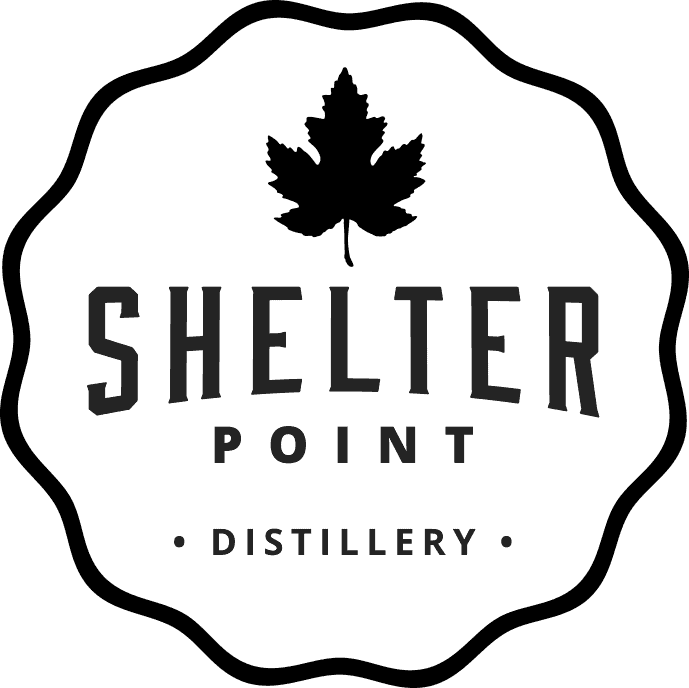
Welcome to the farm
Established in 2011, Shelter Point Distillery is located on 380 acres in Oyster River, BC, about halfway up the eastern side of Vancouver Island on the west coast of Canada. The land encompasses 2,000 metres of spectacular oceanfront, a natural mosaic of streams, a salmon-bearing river, wetlands, forests and fields — all shared with native wildlife, from bald eagles and great blue herons to blacktailed deer and black bears. Farmed for generations, Shelter Point remains one of the last seaside farms on the Island.
Our History
The owner of Shelter Point Distillery is Patrick Evans, a third-generation farmer whose family members were turn of the century pioneers in the Comox Valley. In 2005, Patrick and his family purchased what was once a research farm from the University of British Columbia, part of which was originally owned by his grandfather. The move allowed Patrick and his family to implement their “farmpreneur” vision – one where farming could coexist with wildlife, humans, farming and commerce. Together with Operations Manager James Marinus and a hand-picked team, Patrick has created products that have already placed Shelter Point Distillery on the world stage.
Our Land
Located on the eastern shores of central Vancouver Island, Shelter Point Farm is comprised of more than 380 acres of land including 2,000 metres of oceanfront. The fields that you see embracing the property provide much of the barley that we use to distill our whisky and vodka. In what could be divine happenstance, just below us is a large underground aquifer topped up by the mountain-fed Oyster River. It’s this naturally filtered water that we use in our distillery and to grow our crops. After harvest time, winter wheat and grasses are sown in the fields for the benefit of the many visiting waterfowl who overwinter on the farm.
Our Farming Practices
No till farming – We do not plow or cultivate the soils. Instead, we use a heavy duty grain seeder that cuts through the previous year’s stubble, opening up the ground with a round disc and allowing new seed to be dropped in the soil and then covered for germination.
Winter cover cropping – We overseed harvested fields with winter wheat, rye or winter peas. The idea is to plant crops that will grow during cooler, damp conditions. These crops will uptake any remaining nutrients that are left in the soil and put them into organic form, i.e., the plant itself. This minimizes the potential of soil erosion during winter rains.
Provide wintering feeding grounds for migrating waterfowl and residential wildlife – There is no absolute seasonal treatment that works for improving the fields, but rather a selection of practices that we have in our toolkit to continually rebuild the soil. One field may be be left fallow, allowing what grows to reintegrate into the soil. Our soils vary from field to field. On some, we will apply a heavy spring application of compost or manure. A lot of this is determined by nutrient soil samples and the current year’s crop. Was it successful? Was it lacking anything? Did the crop seem stressed? These are all questions we take into consideration when developing seasonal treatment plans.
Organic matter versus chemical fertilizers – Each year tons of nutrients are absorbed through crop production, leaving the soil depleted of specific nutrients. To create a balance is not a simple matter of applying chemical fertilizers, but increasing the organic matter in the soil.
Stewardship
“As humans, we cannot help but have an impact on the areas we reside in. However, by understanding why we did something in the past, critiquing how we do things today —and allowing ourselves to be wrong – we can certainly change tomorrow for the better.”
— Patrick Evans
Shelter Point Farms has completed an environmental farm plan designed to create a living tapestry of the individual components within the property, including soil capabilities, wetlands, farm buildings and forested lands and creeks: all aspects of the farm that influence and interact with each other. A perfect example of this is encouraging a barn owl to create a nesting habitat in the building itself. In lieu of rent, the owl family works in the late evening, minimizing the rodent population. Our aim is to encourage this wonderful synergy with nature throughout the whole farm. Shelter Point’s habitat enhancement plan will also allow old creeks on the farm to become fish-bearing once again and, by reestablishing ancient oxbows and wetlands, we hope to encourage the return of natural species and migratory waterfowl.
Ducks Unlimited
Ducks Unlimited Canada is a leader in Canadian habitat conservation. They are renowned for conserving, restoring and managing wetlands and grasslands to benefit waterfowl, wildlife and people. When Shelter Point Farms was originally purchased, it consisted of two miles of the Oyster River, along which was an active salmon hatchery. Due to the ecological significance of this section of the river, it was an easy decision for us to gift the majority of the property to Ducks Unlimited.
Click here for more details on the creation of conservation of Bear Creek Nature Park.
HEAR IT FIRST
Sign up for Shelter Point email updates to be the first to know about our newest releases and what's new at the distillery.
